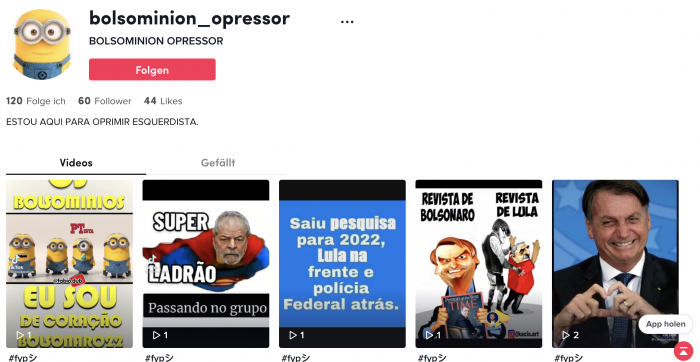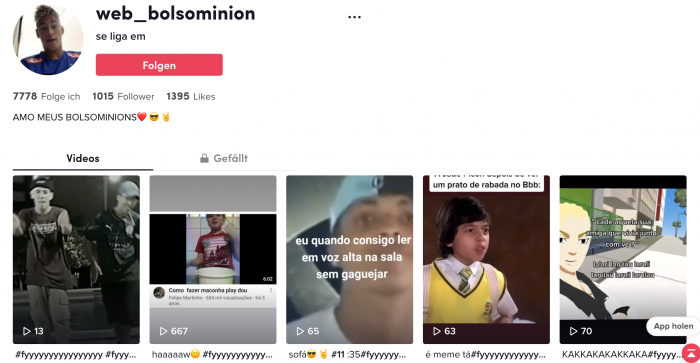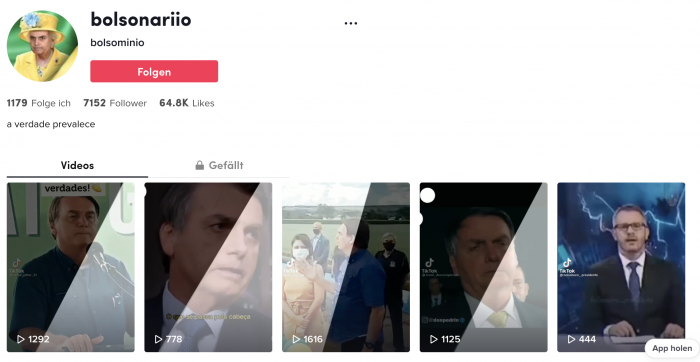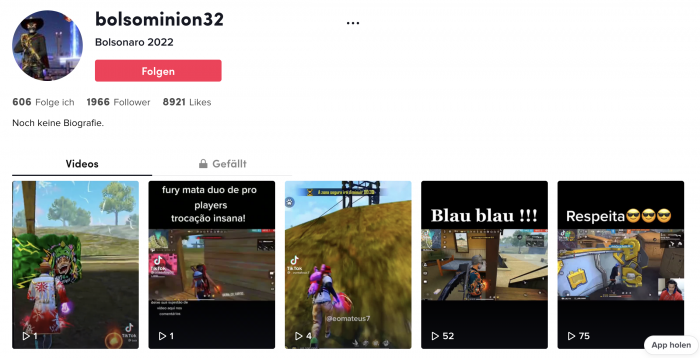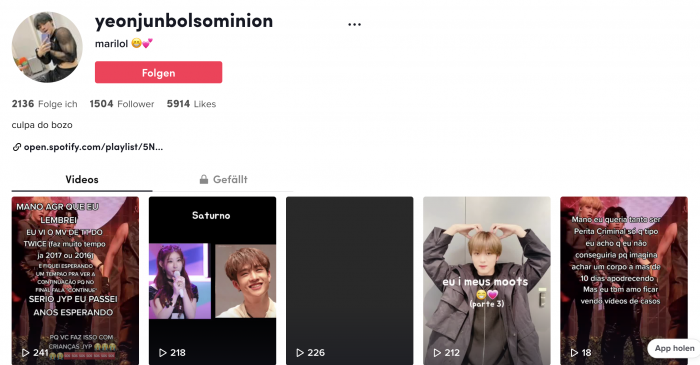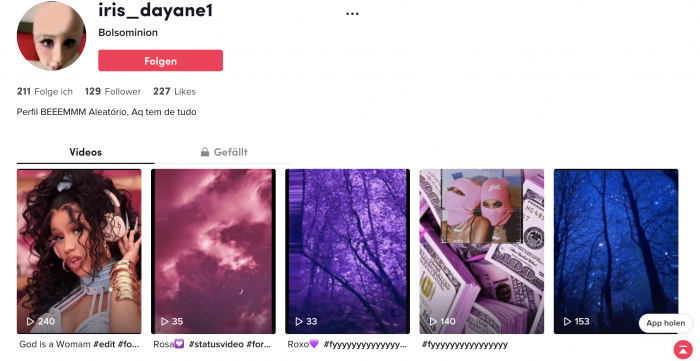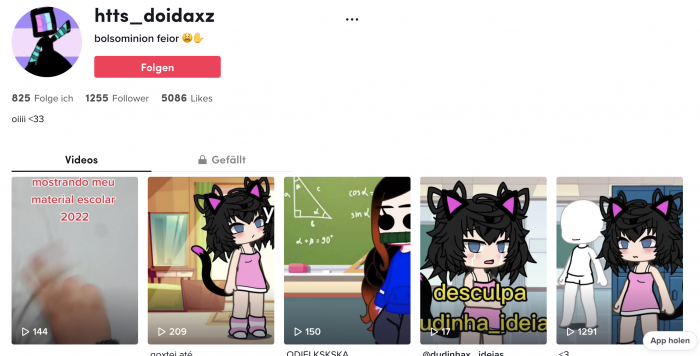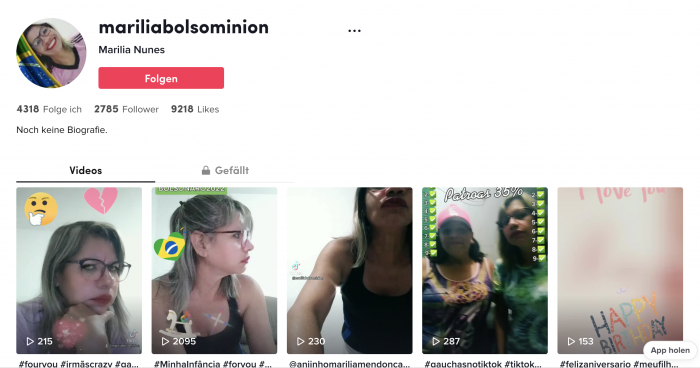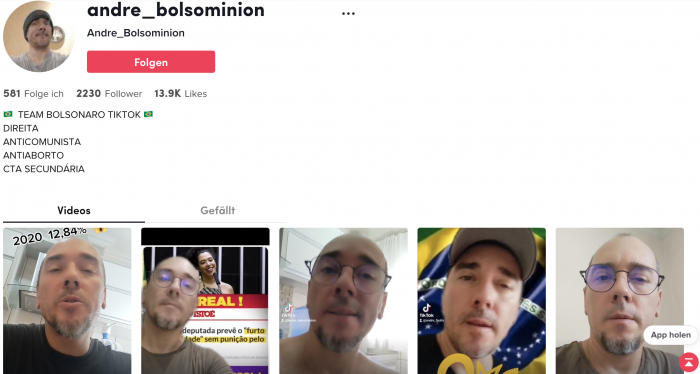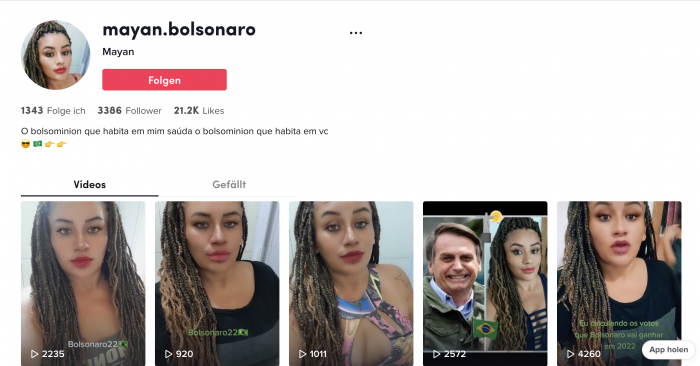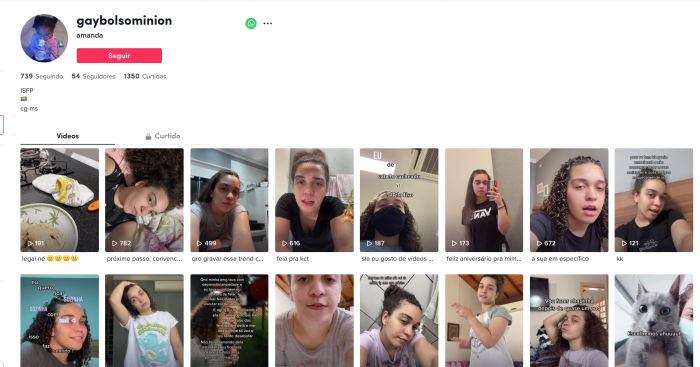Participants: Marius Liedtke, Camilla De Amicis, Geraldine Bengsch, Anna Pruttseva and Fábio Gouveia
Facilitators: Janna Joceli Omena, Thais Lobo, Francisco Kerche, Giulia Tucci and Emillie de Keulenaar
How to cite this report?
Omena, J. J., Lobo, T., Kerche, F., Tucci, G., de Keulenaar, E., Liedtke, M., De Amicis, C., Bengsch, G., Pruttseva, A. & Gouveia, F. (2022). After all, what are bolsobots like these days? SMART Data Sprint 2022. https://metodosdigitais.fcsh.unl.pt/editions/2022-discussing-methods-making/project-reports-2022/bolsobots/
Final presentation slides
Key Findings
Introduction
Research Questions
Query Design & Visual Protocol
Methodology
Findings
Discussion
Conclusion
References
Key findings
Tiktok bolsobots:
- Their goal is to spread and lay the grounds for the upcoming elections.
- Their method is a visual presence and “slogan accounts” via repetitive usernames.
- Bots integrates Bolsonaro’s political, social and cultural agendas (e.g. patriotism, family and religion, conservadorism, alternative news media, LGBT community and memes) and lexicon such as bolsonarista, patriota, fechado com bolsonaro, opressor, bolsolinda.
- Bolsominons (as memetic bots) and ghost accounts (as discrete bots) permeate all agendas/topics.
Twitter bolsobots:
- Bots still do “bot things”: they primarily spread material from “authentic” users, including their identities.
- However, they also become more “unique” in aggregating a wide range of content from pro-Bolsonaro users. While authentic users actively behave like bots as a form of loyalism to Bolsonaro.
The lines between “bots” and “not bots” blur as automation, authenticity and partisanship become interchangeable in online political militantism.
Introduction
The bot factory supporting Jair Bolsonaro’s election and presidency has been tied with accounts of disinformation campaigns (Lobo and Carvalho, 2018; Militão and Rebello, 2019; Mendes, 2021). Social media platforms have taken several actions to block the inauthentic behaviour of these supportive networks, yet not prevent their existence and agency (Euronews, 2021). Bolsobots create fake supportive publics by targeting specific conservative agendas, also LGBT and feminist discourses. They operate based on mainstream and discrete bot accounts (Omena, Lobo, Tucci, et. al., 2021). The former are accounts that generate content, gathering substantial numbers of followers supported by the latter, a diverse range of discrete bots representing different supportive discourses to the Brazilian president Jair Bolsonaro. When operating in discrete modes, bolsobots mimic real people, use private accounts and establish profiles without pictures (ghost accounts) to comment and like content generated by mainstream bots. Thus, whether bots create a distinctive ‘nonhuman’ communication on these platforms flags ethical issues (Maréchal, 2016).
Social media has become a critical opinion platform that political actors use extensively to influence and arguably manipulate public perceptions (Woolley & Howard, 2016). Social bots can be fully or semi-automated by using the technical affordances of the platform they operate on while still retaining elements of human agency (Grimme, Preuss, Adam, & Trautmann, 2017). Interactions on social media follow user-generated protocols on appropriate and acceptable behaviours for the platforms. Here, some research indicates specific bot-like behaviour which may differ from human users, such as frequency and type of posts, including ‘spamming’ of content (Al-Rawi & Roshek, 2018).
Considering that different social media platforms’ affordances and grammar influence each platform-specific dynamics, it is applicable to verify how accounts that figure in Bolsobots networks build their personas in diverse social media environments. Although further analyses are needed, identifying equivalent accounts’ characteristics in different platforms could indicate orchestrated effort to perform multiplatform campaigns and content dissemination. Twitter, the 280 characters limit microblog, is a consolidated data source for research (Steinert-Threkeld, 2018), and the artificial behaviour of accounts within the platform has been extensively studied (Varol et al., 2017; Bradshaw, Hailey & Howard, 2021; Santini, Salles & Tucci, 2021). On the other hand, TikTok is a fast-growing digital platform where users communicate by sharing short videos and reusing the videos’ audio. Since the platform is relatively new, TikTok bots identification and characterization are still unexplored.
This project builds on ongoing research that aims to structure new research questions concerning the behaviour of social media bots online by capturing and profiling bolsobots accounts across social media platforms. It incorporates an analysis of Bolsobots vernacular, collective strategies and particularities on TikTok and Twitter, proposing a close reading of these botted accounts.
Research questions
Tiktok bolsobots RQs
Working group: Janna Joceli Omena; Thais Lobo; Giulia Tucci; Marius Liedtke; Camilla De Amicis; Anna Pruttseva; & Geraldine Bengsch
- How do bot profiles and vernaculars provide information about their presence and agency on TikTok?
- What are web entities associated with bolsobots profile images?
- What can we learn from close reading bolsobots profile pictures and descriptions?
- What are bolsominions? What do they represent, or what role do they play?
- How are ghost accounts associated with Bolsonaro’s different research agendas?
Twitter bolsobots RQs
Working group: Emillie de Keulenaar; Francisco Kerche; Geraldine Bengsch & Camilla De Amicis
- How do bot profiles and vernaculars change over time as users and platforms become more cognizant of their strategies?
- How does the bolsobot ecology on Twitter compare to its TikTok counterpart?
- How have Twitter bolsobots changed from 2015-2022? Is there any evidence of a change in communication strategy?
- How does dynamic bot-like “behavior” affect current bot detection methods, like Botometer?
Query design & dataset building
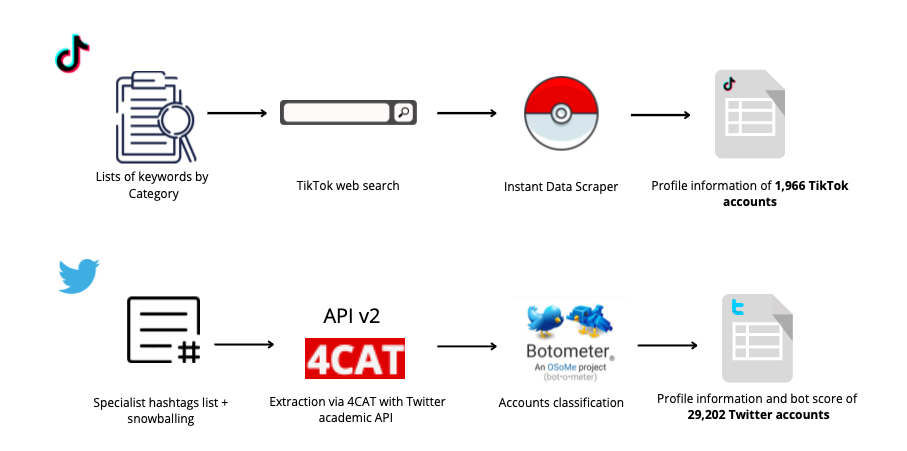
Visual protocol: query design and dataset building
For TikTok, the dataset building follows a query design technique based on account names and bot profile characteristics. We looked at the number of followers, the type, format and style of publications and or profile pictures, and the lack of profile photos or publications. To capture such type of account, we searched on TikTok for a list of specific keywords resonating with different political, social, cultural and religious fronts that bolsobots take part in (see Omena, Lobo, Tucci, et. al., 2021). During the data sprint and when collecting the URLs of the accounts with Instant Data Scraper, some keywords from the initial list were excluded (see below) while others were included (in pink).
Categories and respective keywords used to capture TikTok bots accounts
- Patriotism & Bolsonaro: bolsonaro/bolso, reeleito, 2022/22, brasil, pátria/patriota, partido, armamento/arma, presidente, mito, bolsonarista, monarquista/monarquia, fc/fã, 17, 38, gado, capitão, 🇧🇷, 😎, ✅, exército, fechado
- Family & Religion: deus, jesus,
cristão/cristo, família,casado(a), pai, mãe, 🙏
- Far-right vs. Left: direita, endireita, conservador, opressor, soldado
- Conservative Feminism: mulher, feminista, mulheres com bolsonaro, bolsolinda, princesa
- LBGT: gay, lgbt,
🏳️🌈, 🌈
- News: news, tv, noticias,
direita da opressão, canal
- Memes: bolsominion, meme, memes
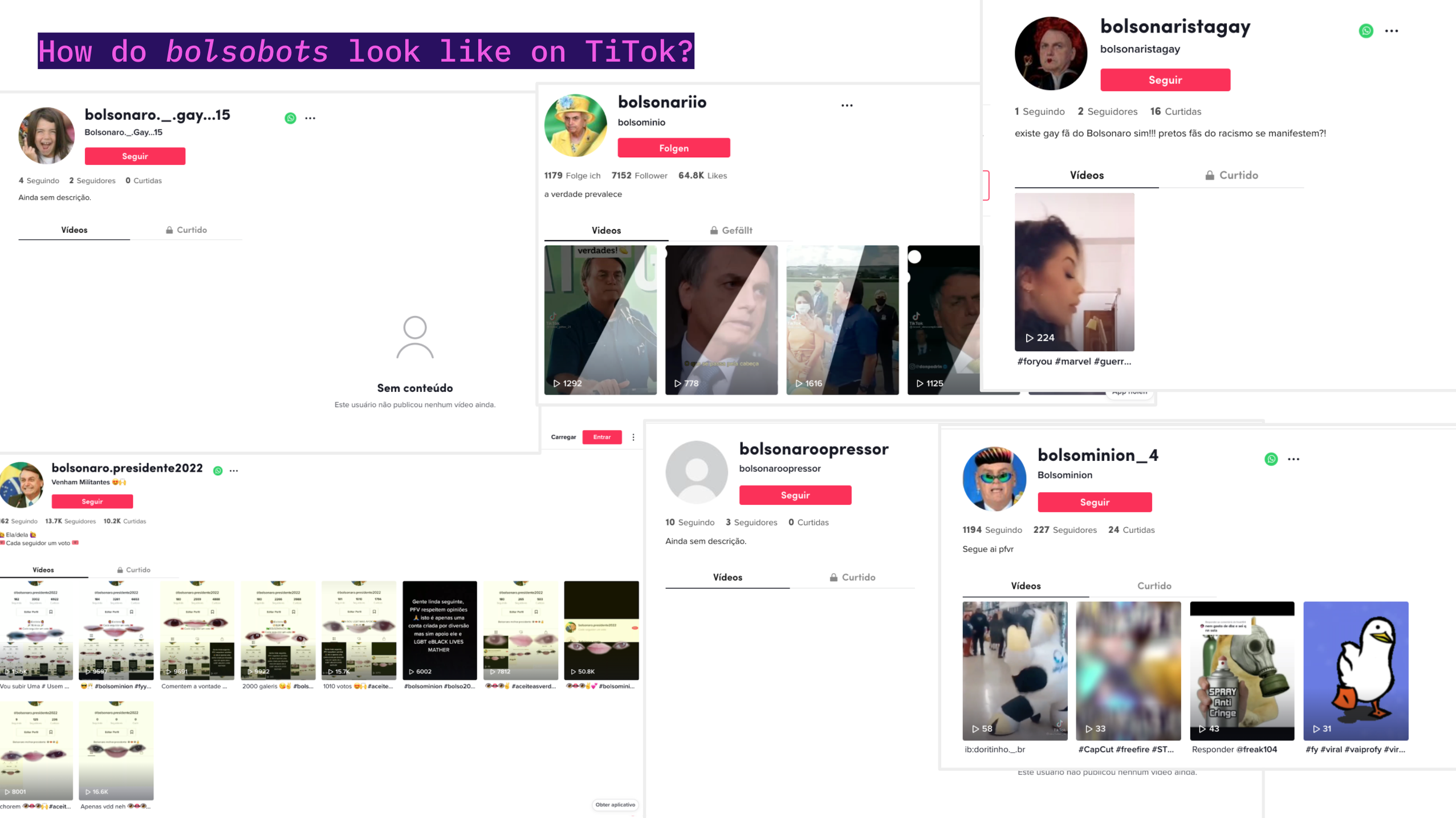
How do bolsobots look like on TikTok? Examples of bot accounts.
For Twitter, a different list of keywords served as entry points to capture accounts, containing a specialist hashtag list and following a snowballing technique. The keywords here also respond to specific categories such as conservative feminism, family and religion, left vs right, news, patriotism, etc. 4CAT (Peeters & Hagen, 2021) supported data collection with Twitter Academic API. Bot classification relied on Botometer, built on Twitter usage cultures and specificities, to verify accounts’ activities and assign a score to them. Twitter accounts are thus checked with a high (or low) probability of being, for instance, fake followers and spammers. More bot-like behaviour means a higher score.
Categories and respective keywords used to capture TikTok bots accounts
|
Category |
platform |
keyword |
boolean |
|
Conservative feminism |
|
mulheres com bolsonaro |
(mulheres com bolsonaro) OR |
|
Conservative feminism |
|
bolsolinda |
bolsolinda OR |
|
Family and religion |
|
#defendamnossosfilhos |
#defendamnossosfilhos OR |
|
Family and religion |
|
#ideologiadegenero |
#ideologiadegenero OR |
|
Left vs right |
|
hienas |
hienas OR |
|
Left vs right |
|
#foracomunismo |
#foracomunismo OR |
|
Left vs right |
|
#foraforodesaopaulo |
#foraforodesaopaulo OR |
|
Left vs right |
|
#forodesaopaulo |
#forodesaopaulo OR |
|
Left vs right |
|
#hienasdetoga |
#hienasdetoga OR |
|
Left vs right |
|
#marxismocultural |
#marxismocultural OR |
|
News |
|
#globolixotraidoradapatria |
#globolixotraidoradapatria OR |
|
Other |
|
#controlepopulacional |
#controlepopulacional OR |
|
Other |
|
#engenhariasocial |
#engenhariasocial OR |
|
Other |
|
#infeliz2030 |
#infeliz2030 OR |
|
Other |
|
#novaordemmundial |
#novaordemmundial OR |
|
Other |
|
#omscomunista |
#omscomunista OR |
|
Other |
|
#omsgenocida |
#omsgenocida OR |
|
Other |
|
vacina AND #greatreset |
vacina AND #greatreset OR |
|
Patriotism |
|
#bolsomito |
#bolsomito OR |
|
Patriotism |
|
#bolsonaro2022 |
#bolsonaro2022 OR |
|
Patriotism |
|
#bolsonaroestamoscontigo |
#bolsonaroestamoscontigo OR |
|
Patriotism |
|
#bolsonaroorgulhodobrasil |
#bolsonaroorgulhodobrasil OR |
|
Patriotism |
|
#bolsonaropresidente |
#bolsonaropresidente OR |
|
Patriotism |
|
#bolsonaropresidente17 |
#bolsonaropresidente17 OR |
|
Patriotism |
|
#bolsonaropresidenteate2026 |
#bolsonaropresidenteate2026 OR |
|
Patriotism |
|
#bolsonaroreeleito2022 |
#bolsonaroreeleito2022 OR |
|
Patriotism |
|
#bolsonarotemrazao |
#bolsonarotemrazao OR |
|
Patriotism |
|
#brasilacimadetudodeusacimadetodos |
#brasilacimadetudodeusacimadetodos OR |
|
Patriotism |
|
#confiamosembolsonaro |
#confiamosembolsonaro OR |
|
Patriotism |
|
#quantomaisbolsonaromelhor |
#quantomaisbolsonaromelhor OR |
|
Patriotism |
|
#somostodosbolsonaro |
#somostodosbolsonaro OR |
|
Patriotism |
|
#brasilacimadetudo |
#brasilacimadetudo OR |
|
Patriotism |
|
#patriota |
#patriota OR |
-
TikTok: Capturing and profiling bolsobots personas
The methodology for studying TikTok bolsobots originated from previous research on bot studies on Instagram (Omena, Lobo, Tucci, et. al., 2021) and Tumblr (Omena (Omena, Chao, Pilipets, et al., 2019). Empirical work on Instagram has shown that bolsobots’ categories align with specific publics and values generally associated with Brazilian conservative political agendas, particularly Bolsonaro’s agenda and supporting publics: patriotism, family-religion, security and anti-communism (Omena, Lobo, Tucci, et. al., 2021). When navigating the TikTok environment, one can easily detect the same account profiles. We, thus, saw and listed 1,966 TikTok accounts following a detailed tutorial (Tutorial: TikTok Bolsobots Dataset Creation).
In addition, digital visual methods and exploratory data visualisations played a significant role in our methodological procedure, as we explain below.
Using web entities to make sense of a collection of bolsobots profile pictures
We took advantage of Google Vision’s web detection to conduct web entities analysis. By following a computer vision network approach (see Omena et al. 2021), we were able to overview what constitutes bolsobots profile images. Web-based tags underlined the cultural, political and or social context of these images. We first downloaded all images with DownThemAll (Maier, Parodi & Verna, 2007). Then, we uploaded the image folder on Memespector-GUI (Chao, 2021), and with its outputs, we generated a network of co-occurrences of web entities. Finally, we identified the main clusters and bridging nodes when visually approaching and navigating the network.
Account Analysis to grasp the different fronts/categories of bolsobots
For account analysis, we combine image walls analysis with the closing reading of profile descriptions using alluvial diagrams (for word frequency analysis according to bolsobots categories), image treemaps (for profile image analysis according to the number of followers) and emojis grid (according to bolsobots categories). We generated two image walls: one focused on the studies of images according to bolsobots categories (e.g. memes, patriotism, family), having images clustered by colour pattern. While the other had account names as an entry point to profile image analysis. In the latter case, we filtered all images matching the names of the accounts containing “presidente” and “jair ” to cross-check what visual content was related to these accounts.
To better understand bolsobots contexts, we have closely read profile descriptions using alluvial diagrams in RawGraphs. We did a word frequency analysis according to bolsobots categories in these diagrams. Across all categories the most prevalent words are bolsominion, fechadocombolsonaro, acima, segue, deus, brasil, bolsonaro, bolsonaro2022.
Ghost accounts mapping to provide empirical evidence about their role within bot ecosystems
Bots, in general, use accounts without a profile picture, bolsobots are no exception to this rule. This bot type, the so-called ghost account, is always present within the automation marketplace, also taken as bridging nodes (Omena 2019, DMI project report 2020). Considering such characteristics, we mixed visual network analysis with the detection of unique ghost accounts to cross-check Bolsonaro’s research agendas through account name and how active these ghost accounts were (in terms of content generation).
-
Twitter: Capturing and profiling bolsobots behaviour
Mapping a taxonomy of Twitter “bots” based on bolsobot hashtags
Considering the text-based structure of Twitter, we used hashtags as a strong indicator of how users would behave on the platform. To do so, we used R programming to extract patterned speech with regex patterns. With this information, we would cross the user, their botometer score pulled earlier, and their hashtag’s timestamp. This technique is a promising matter of analysing the taxonomy and the vernaculars involved in the bolsobots universe. Hashtags produced two main aspects to be searched for, the creation of hashtags (the first time they appeared), their average duration and their repetition. The variety of strategies of using different platform affordances (retweeting, linking, mentioning, using hashtags, etc.) between the other botometer scores was also a critical aspect that was considered.
The division between these different affordances was created based on columns that were originally from the data-set scrapped from the platform, as also from the structure of the text, detecting links and hashtags through patterns of text.
Examining the evolution of bolsobots between 2015-2022
Another question that was in our sight was how these users would change their way of acting, their presence or centrality over time. This comes from two different data sets created at different times. Most analyses were made in 2017, when the number of tweets was significantly higher than the previous years. This was particularly useful to analyse changes in vocabulary, primarily using the tidytext package in R, which acts in a Bag of Words (Bow) method of analysis. A tidy approach toward textual data allows researchers to cross-references between already present data in the data-set – such as botometer score, dates, and others – with the linguistic presence and variability over time.
Exploring user debates about bot identities and behaviour
While observing these different aspects, we used qualitative observations to see how users would talk about bots and in what context did bots appear as a topic of discussion. The idea was not only to see how bots or non-bots would act, but how their image can be socially constructed between the actors engaged in political disputes. For that logic, we used … to compare users that would accuse others to be bots, would take “bot” as part of their identity, and finally, that would give a judgement of value. We would then cross this data with the original botometer scores to see who, among the users, would say one thing or the other.
-
TikTok: Capturing and profiling bolsobots personas
Computer vision analysis: Bolsobots as politics, memes and humans
When looking at the network of co-occurrences of web entities to make sense of 1.966 bots profile images, three significant clusters stand out: politics, memes and humans. In a general depiction, the political cluster exposes names of politicians, Brazilian mainstream media (Veja, TV Globo, Folha de São Paulo, BBC Brasil, IstoÉ) and references to the general elections of 2022 and 2018. Moreover, what characterises Bolsonaro’s political profile (social liberal party, ultraconservatism, bolsonarism, far-right politics, military theorist, denialism), pop culture (música sertaneja, big brother brasil) and web apps such as telegram. Integrated into the meme cluster, we see YouTube, Instagram, Reddit, Imgur, Know Your Meme and TikTok itself. The temporal references associated with meme bots are relatively fresh, which is noticed by the entities: 2021 and 2020. An intriguing component that captured our attention was the entity in charge of connecting the meme to the political cluster: bolsominion. We will further provide a case study about the bolsominions.
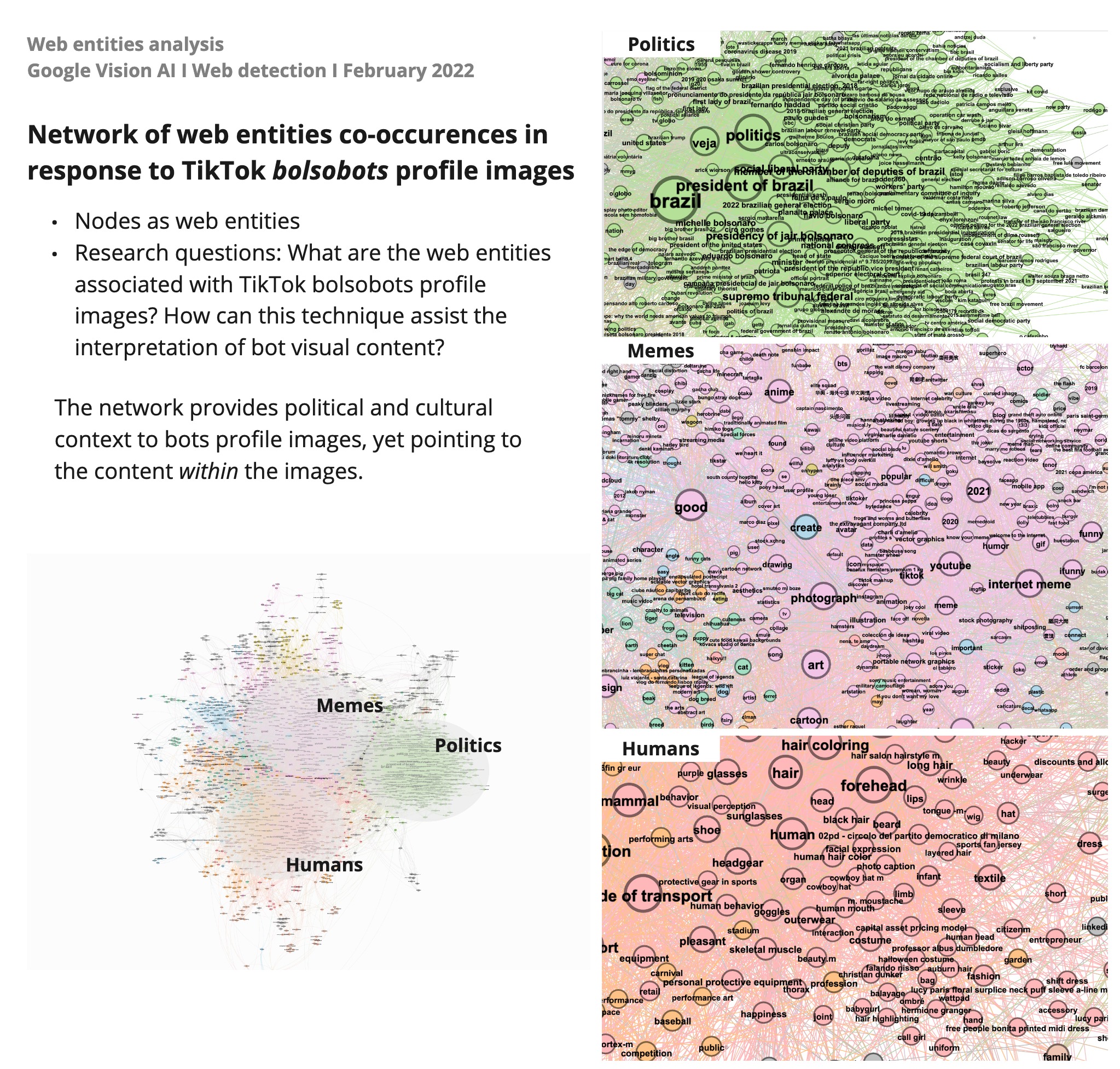
The last cluster reveals that TikTok bolsobots image profiles constitute humans, mainly males and, in a small number, females. Here, the happiness entity is heavily present. As later detected through the image walls analysis, Bolsonaro himself is the dominant visual content, including various pictures in which he is happily smiling.
Another intriguing bridging node was the web entity harmful associated with Bolsonaro pictures and the Brazilian flag. Bots use these on Tiktok to feed their profile images. It is still unclear how Google Vision AI and Google’s robust Knowledge Graph are using harmful to classify these images. Would Bolsonaro himself and the Brazilian flag become synonymous with causing or likely to cause harm? To further investigate that, We looked at the list of web pages in which fully matching images are found, yet corresponding to the images we see below. Besides social media (Twitter and Facebook), Brazilian news media websites (cnnbrasil.com.br, uol.com.br), alternative and partisan news media (tijolaco.net, metropoles.com) were the sites of image circulation. This list also includes international news pages such as newsbrezeer.com and baaju.com (both with the same interface and design) and meme environments (memedroid.com). Web entities point to web context-based information. That is material indexed according to what Google considers as page quality or how the search engine may deliver results based on parameters like expertise, authoritativeness and trustworthiness (see Google’s search quality evaluating guidelines). In other words, defining presidential pictures of Bolsonaro and the flag of Brazil as harmful is not only an output of Google Vision AI but also “reliable” information (so to speak) made available on the surface of the web.
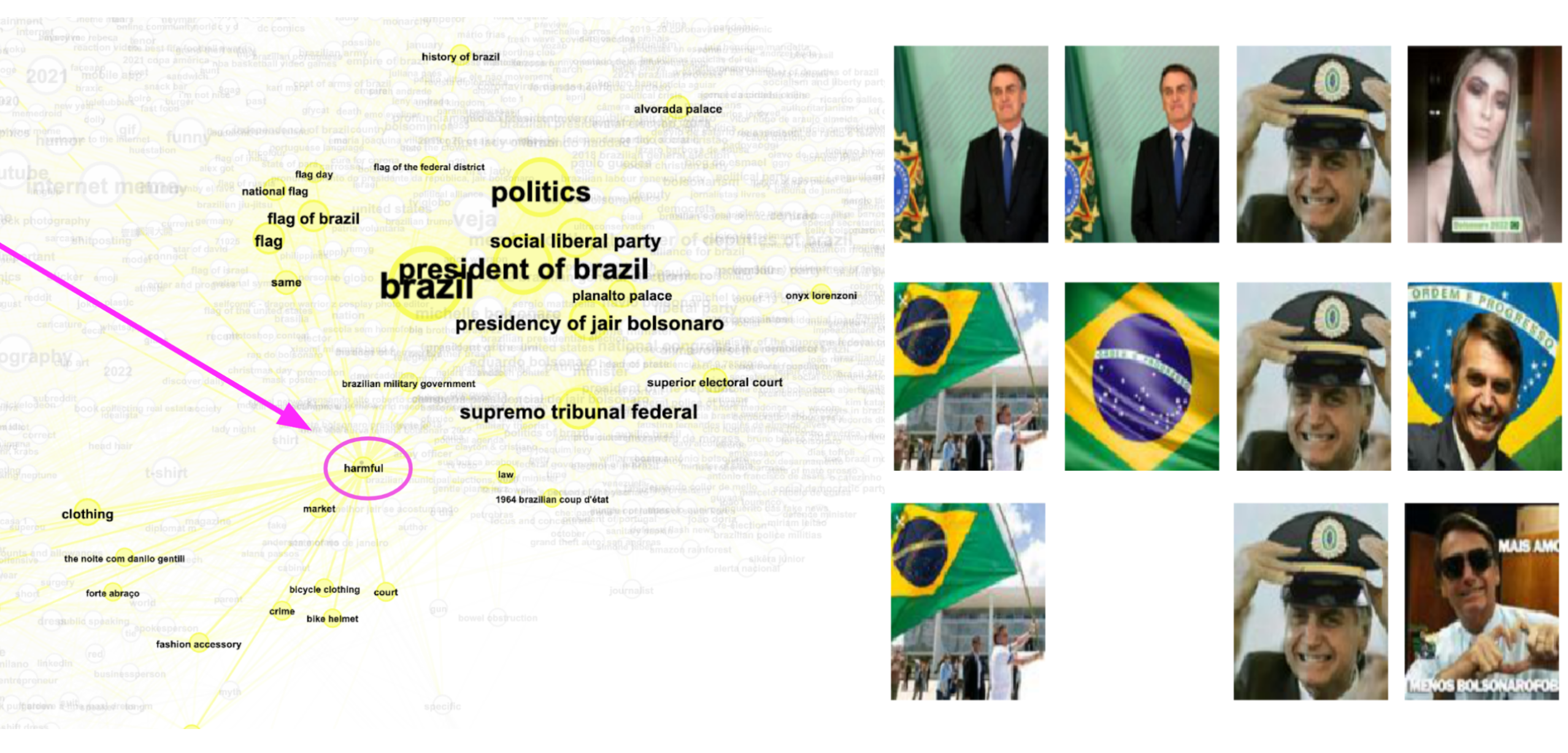
Bolsonaro pictures used as bots profile images are stated as harmful entities.
Ghost accounts analysis: bolsobots as discrete and supportive agents of Bolsonaro’s research agendas
To visualize the relation between the TikTok bolsobots username and the profile pictures, we created a bipartite network of the unique images and respective usernames of the profiles that used the picture. Since not always equivalent pictures have the same name file (and consequently different URLs), we followed two steps to identify and merge these files into unique pictures:
- By using the digest R package (Eddelbuettel, 2021), process the images hashes’ to unify equal images that had different names;
- Use PicArrange (Jung et al. 2021) to sort images by colour and manually identify and rename the remaining equivalent images.
The profile picture – username network is an ensemble of ego networks. The focal nodes (ego) are the pictures connected to the individual profiles that selected this image as their TikTok avatar. The classic “ghost account” profile picture is in the centre of the graph, also the most frequent picture in our TikTok bolsobots sample. 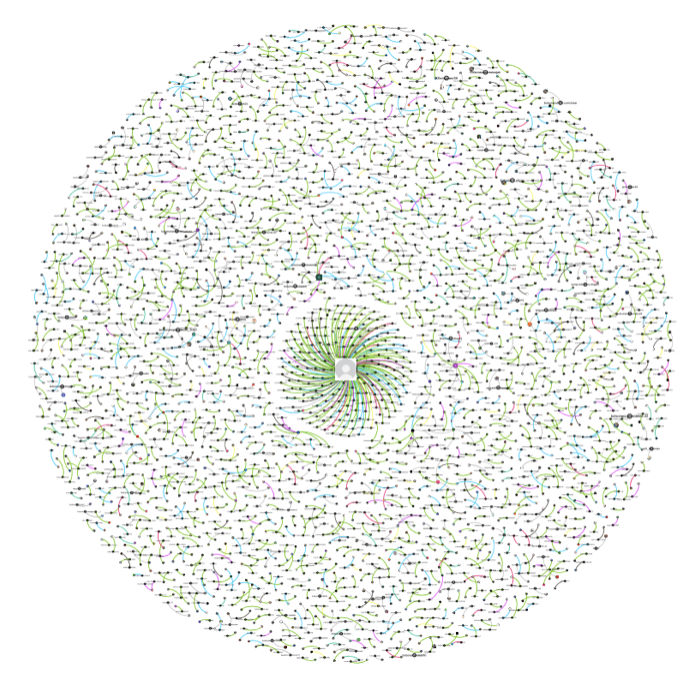
Then, we conducted a manual analysis of the 177 bolsobots profiles with the classic ghost account profile picture and verified that 151 accounts haven’t published any content. Maintaining a social media profile without posting any content, or uploading an image profile is not only an indication of discrete bot behaviour. That is, accounts purposefully generated to like, comment and follow — and unfollow — other accounts (DMI project report, 2019). With TikTok bolsobots, the name of the accounts leaves no doubt; they are created to permeate all discussion threads supporting Bolsonaro’s agenda. For example, fechadocombolsonaro45 (patriotism), bolsonarodejesus (religion) and bolsonarogay (LGBT). More examples are below. These accounts are expected to be present for the 2022 Brazilian presidential elections, quietly and without attracting attention, contributing to boosting content.
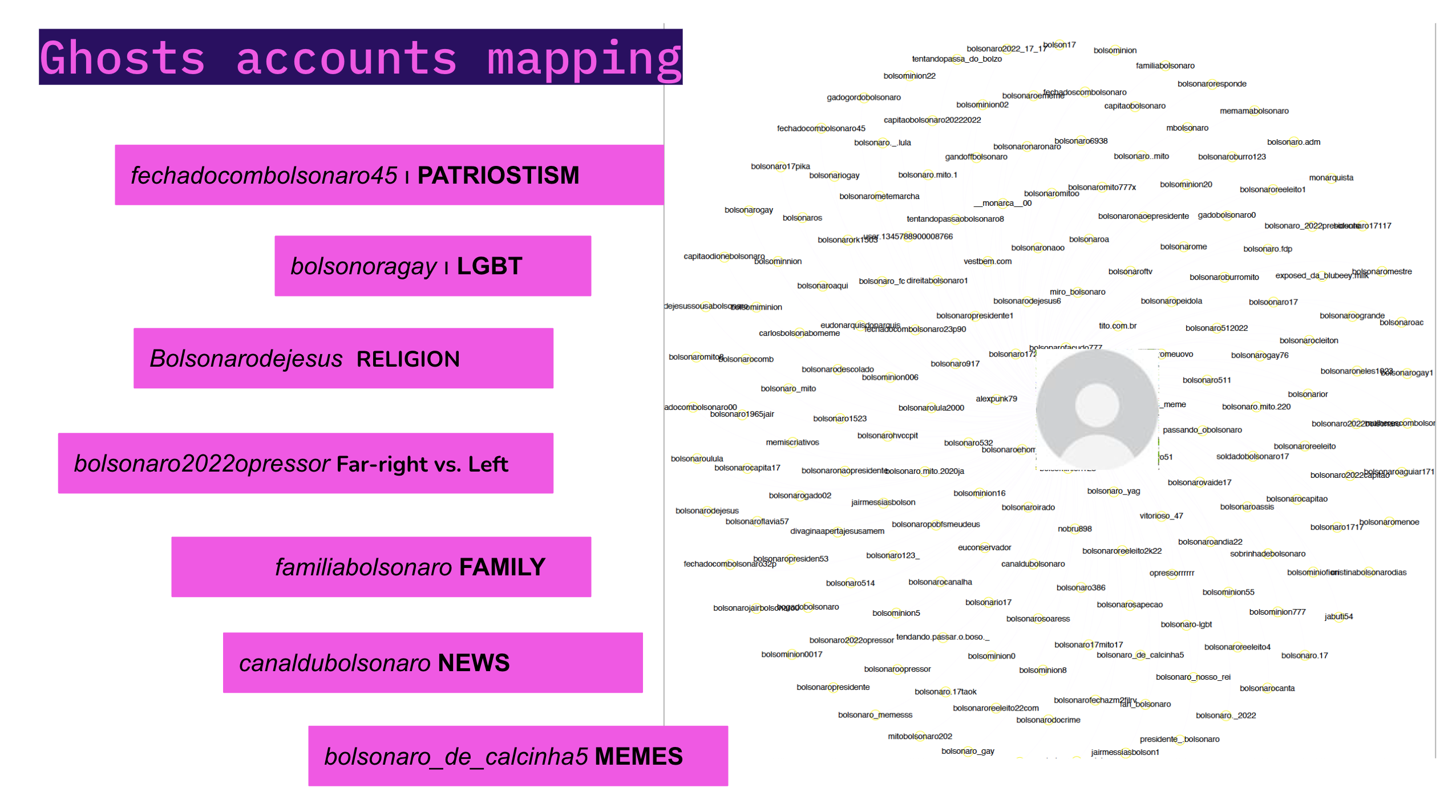
Account analysis: from bots vernaculars to bolsominions
-
Account analysis (1): Bot profile description (emojis and text)
Tiktokers in the corpus use fewer emojis in their user description than bolsobots accounts found in other social media platforms researched (i.e. Instagram, Twitter), pointing to a particular way to engage with the platform and the use of other resources to show alliance. Nevertheless, the types of emojis chosen by the accounts are in line with the main rhetorics of Bolsonaro’s supporters.
The most frequent (by far) emoji used in the account’s description is the Brazilian flag 🇧🇷, primarily associated with right-wing political groups in Brazilian politics in recent years. The presence of hearts in green and yellow 💚 💛 operate as other symbols of patriotism but also indicates a broader loyalty to “bolsonarismo” ideas, as well as hearts in different colours ❤️ ♥.
Moreover, the use of emoji number 2️⃣ among the top 30 emojis signals the role of the 2022 elections in the dataset. Other emojis such as 🔥💥😂 also point to the reliance on viral and memetic content, underpinning the influence of these accounts in a broader information ecosystem.

When analysing the frequency of keywords in the profile descriptions (with alluvial diagrams), there are bolsominion mentions in all categories. It is a popular meme topic across all categories. Also, there are bot profiles mentioning the 2022 Brazilian general election in all categories. The “Trump” keyword is not that frequent but can be found in Patriotism, Far right vs left, LGBT categories. As for surprising outputs, LGBT has a unique set of keywords compared to other classes; we found some keywords connected to religion (deus, amem, cristao, fe).

-
Account analysis (2): Image Walls with bot profile pictures
We used the ImageSorter tool to analyse profile images of TikTok bolsobots, keeping in mind the keyword categories presented in the Query design section. Bolsonaro’s images identically or in different photo styles repeat across categories. There are 10-15% (depending on the category) bolsobots accounts without profile image. Frequently these profiles are represented with a “B” by the platform. TikTok marks profiles without images with the account name’s first letter label, which indicates the frequent use of “Bolsonaro” as an account name.

When closing analysing the categories, some specific observations are associated with each. For example, in the patriotism category, there are images with 2022 inscriptions showing that the accounts are already engaged in the forthcoming Brazilian general elections. In some cases, the year appears with personal photos. We also found examples of the 2018 election. Also, the profiles depict recurrent themes related to Bolsonaro’s “patriotism ideals” such as monarchy, army, and agrobusiness.

The Far-right vs Left cluster, along with the Brazilian flag, this cluster features symbols and politicians related to the United States conservative party. The divide between right and left is not as prominent as expected; a few profiles represent it. We put two accounts examples in the following illustration.
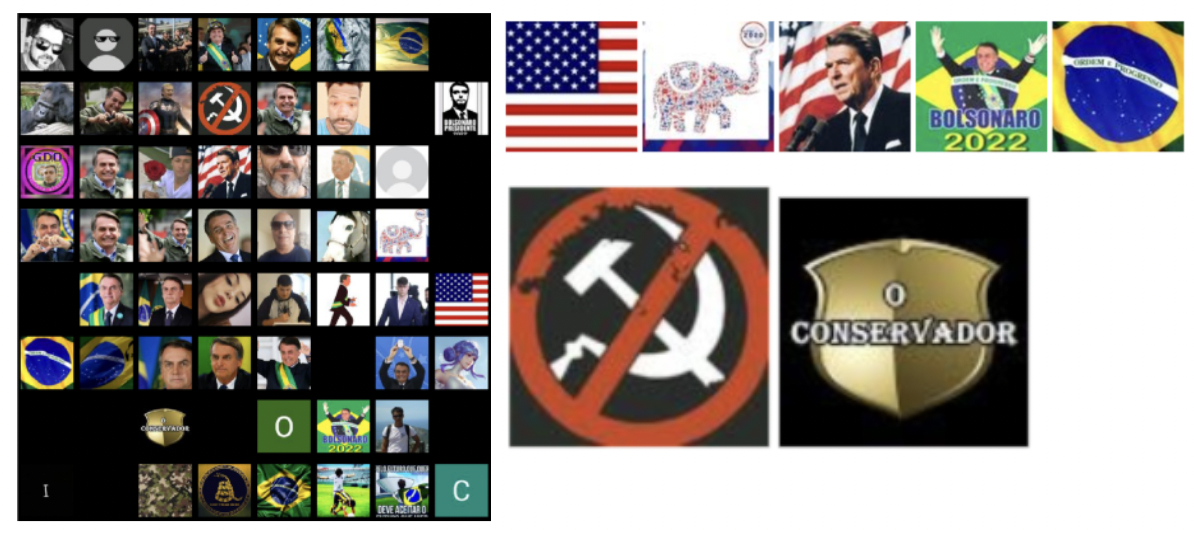
The news category has a low image repetition rate, pointing to a more sophisticated bot behaviour. The majority of profile pictures are composed of variations of Bolsonaro’s photos. Similar to the patriotism category, some profiles have images connected to the 2022 Brazilian general election. We found some media channels mentioning Bolsonaro.

As for the family and religion category, nearly 17% of the profile images are images of Bolsonaro with a high repetition rate. On the other hand, approximately 10% of images are images of people (which is more compared to other clusters).
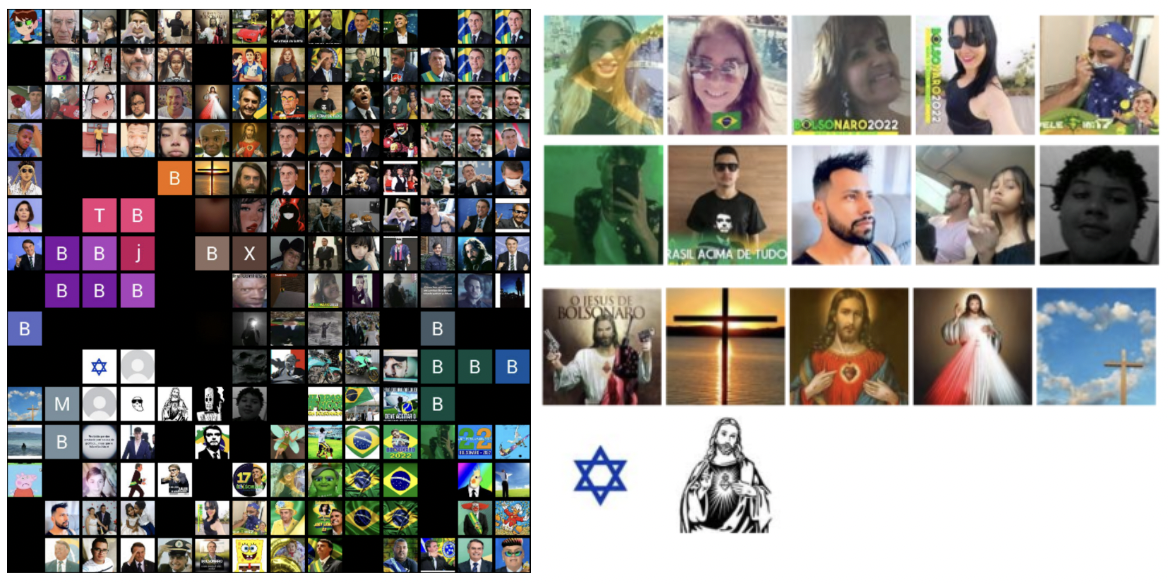
-
Account analysis (3): usernames vs profile picture
Additionally, has been conducted specific research regarding the relationship between the name of the accounts and the profile images. In particular, the accounts that contained in their names the words “presidente” and “jair” have been analysed, two specific expressions addressing the figure of Bolsonaro. Although both keywords would ideally lead to several accounts whose profile images are predominantly consistent and homogeneous (Bolsonaro himself), results showed a wide variety and heterogeneity of images.
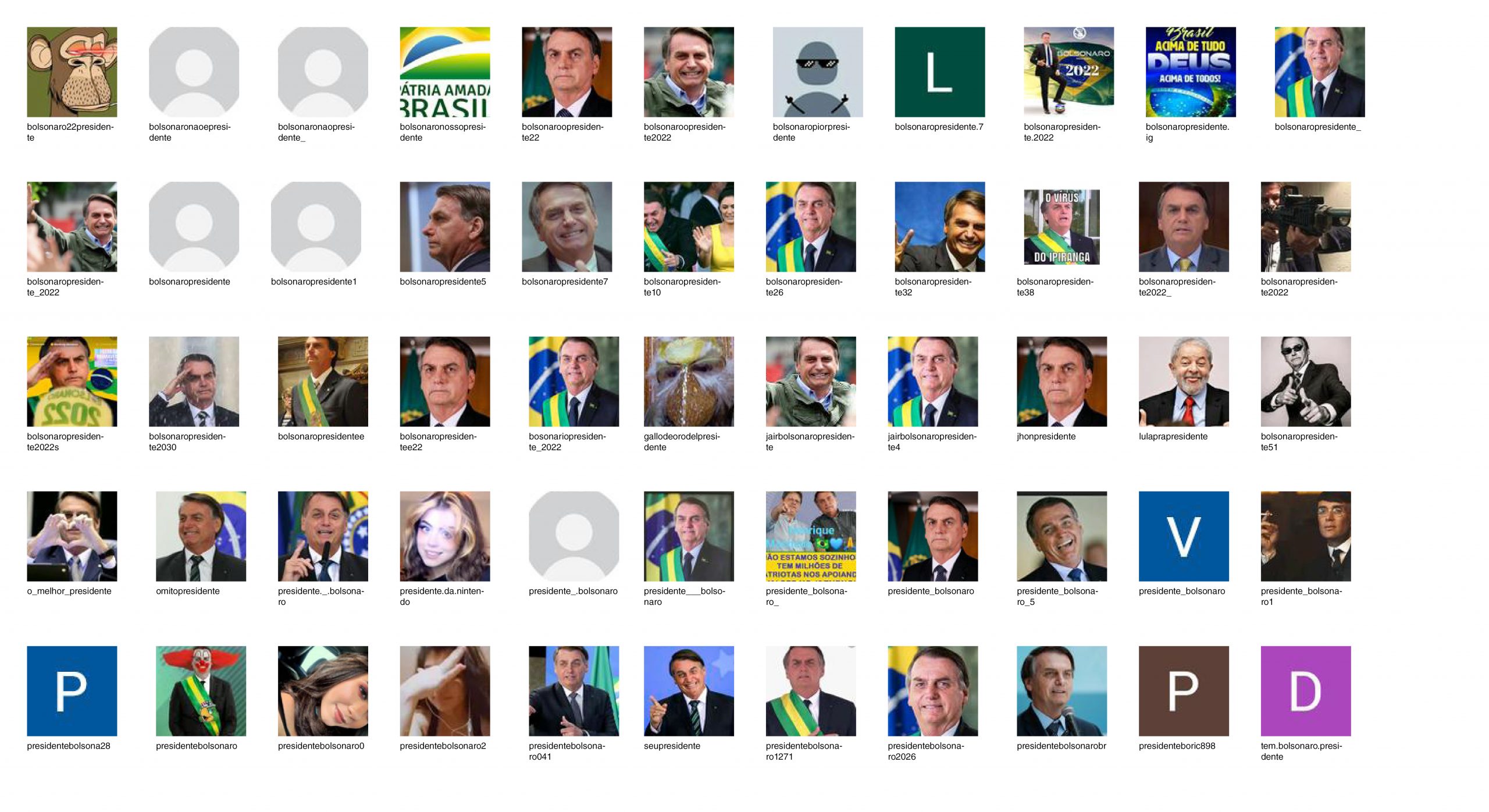
Profile images were extracted from the folder of bot profiles containing “presidente” in their names.
For example, in this first case, the different images showing Bolsonaro represent the leader through various aspects. They offer the empathetic side through smiling and affable photographs and the institutional side and the military role. But an exciting part is occupied by the ghost accounts present here with the typical grey and white images and some alphabet letters on a coloured background. Finally, a cluster of interest is where profile pictures follow current viral trends. Examples of this are photos of young girls or the image of the well-known NFT work depicting a monkey, which has been at the centre of numerous scandals due to accusations of racism.
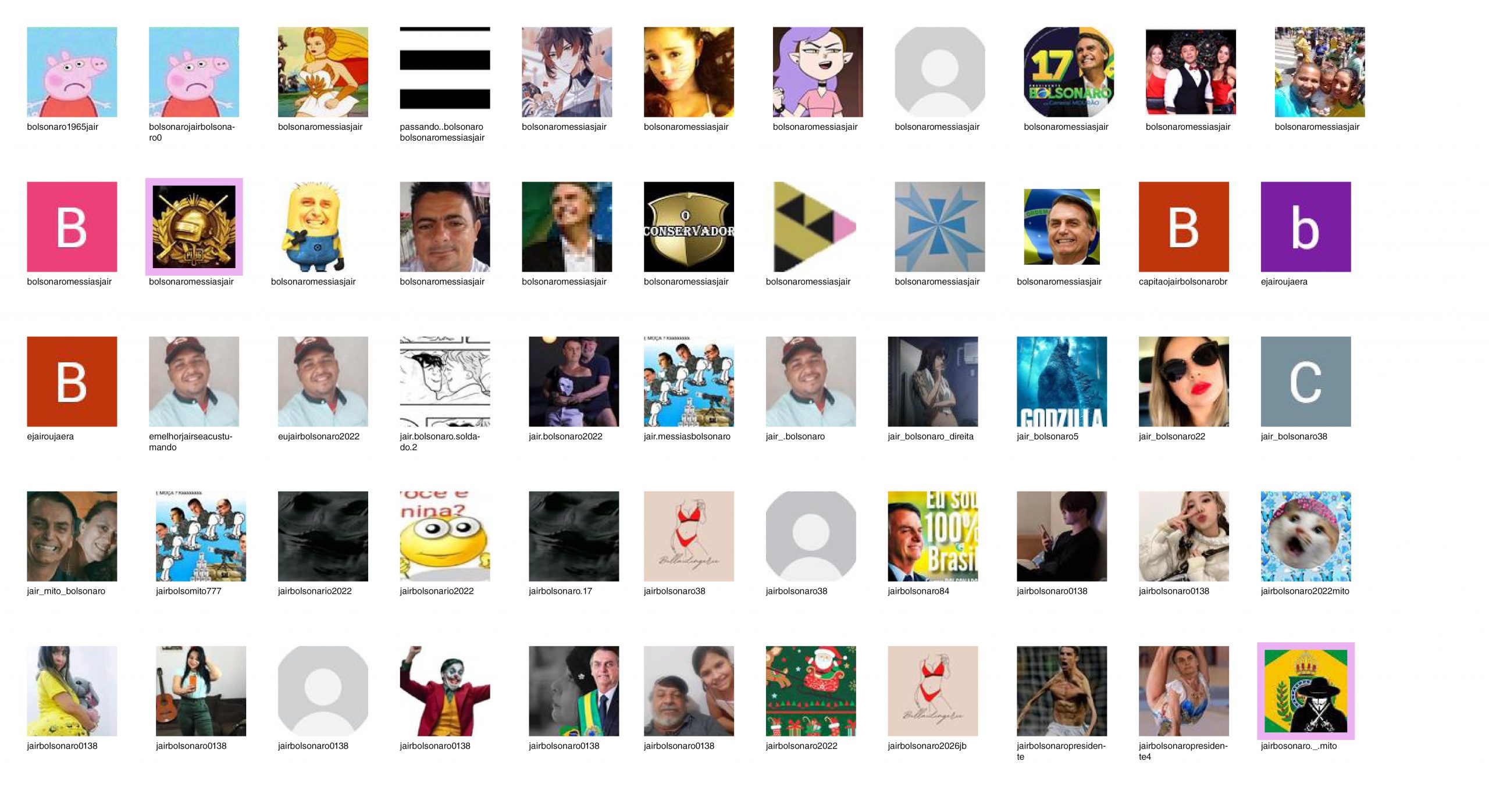
Profile images were extracted from the folder of bot profiles containing “jair” in their names.
Here the resulting images are fascinating because, associated with the exact name of the leader, microscopic images of himself show up. Instead, again recurs, the presence of ghost accounts. But the most consistent set of images here includes random images and a good presence of images referring to feelings of “nostalgia” and “melancholy” linked to different worlds such as sport, cartoons or pop actors, all connected to trends but with no apparent direct association to the political world.
Using image treemaps of bolsominions bot accounts is another technique for grasping the relationship between the name of the accounts and the profile images. The visualisation is divided into three different maps, in which the size of images responds to the number of TikTok followers. From top to bottom, we see the overwhelming visual presence of Bolsonaro himself, followed by memetic accounts, particularly bolsominions. Ghost accounts are predominant among those with less the twelve followers.
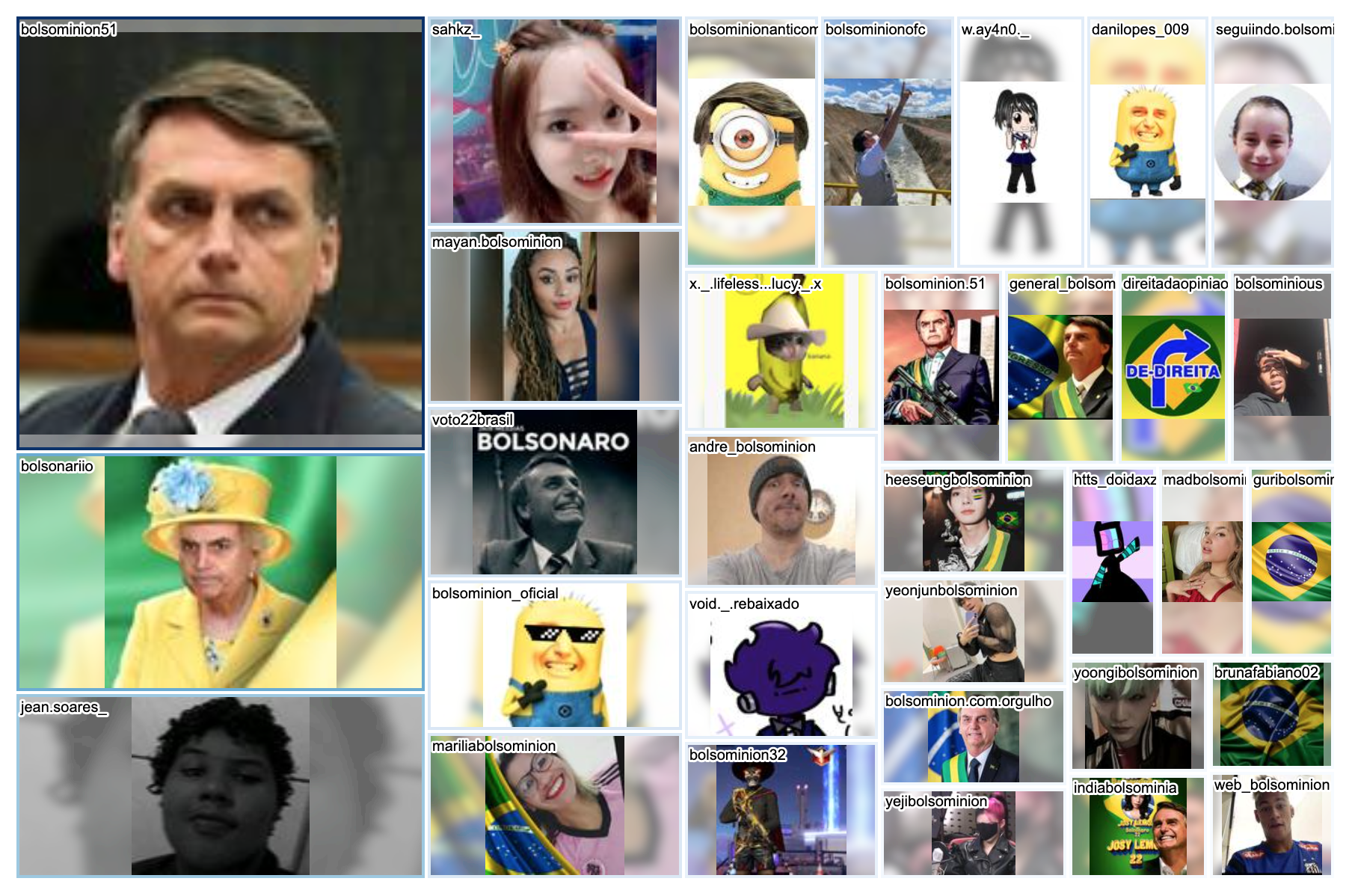
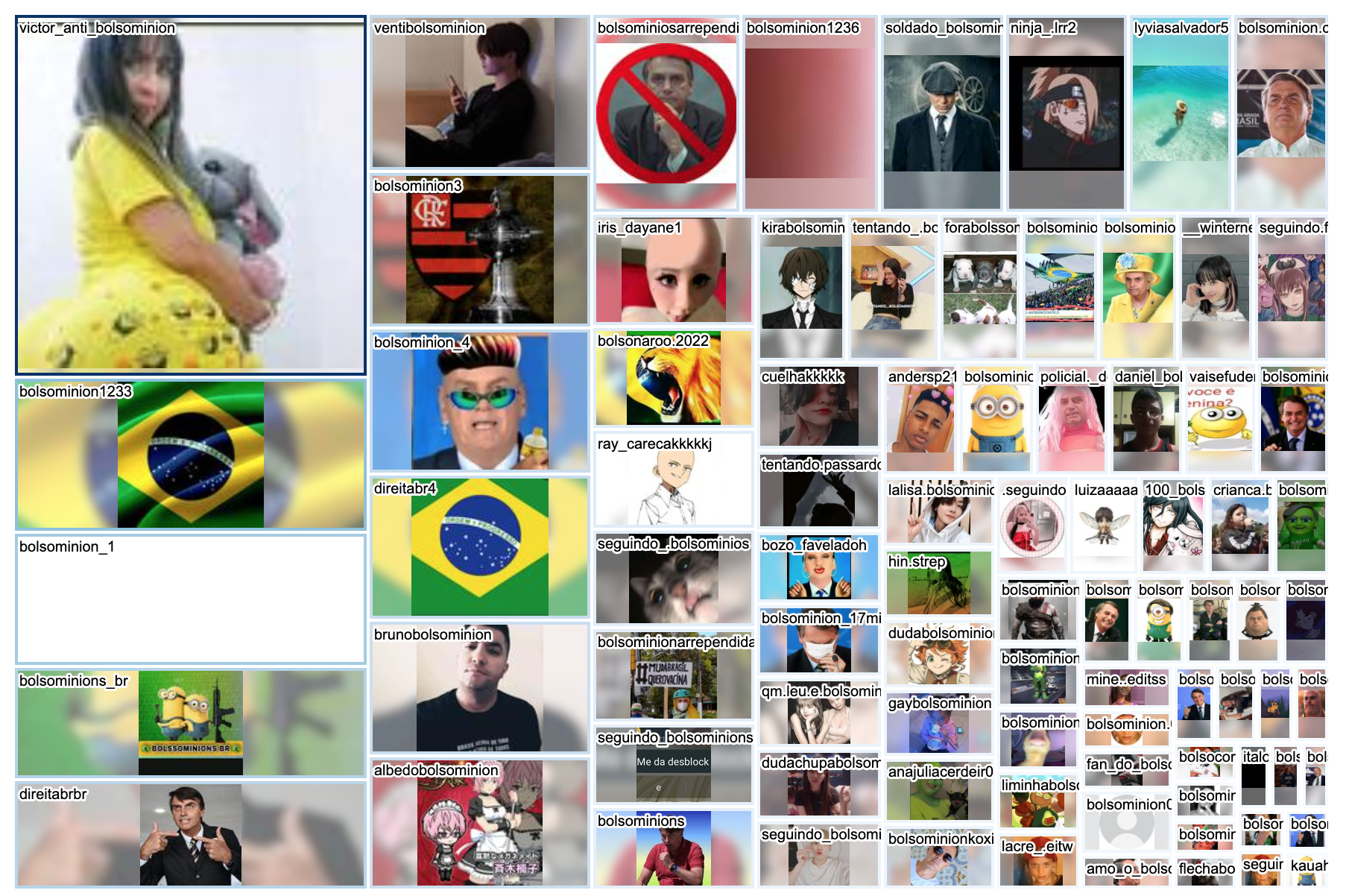

Image treemaps of bolsominions bot accounts. Image profiles are sized according to the number of followers. At the top13.000 to 1000 followers, in the middle 800 to 12 and at the bottom, 12 to 0.
-
Account analysis (4): bolsominions
The term “bolsominion” showed up throughout all results of our search queries. It is an amalgamation combining the first half of Bolsonaros surname and the word minion, meaning “servant” or “follower”. However, minion is also the name of the popular yellow characters of the animated movie franchise Despicable Me. Images referencing these movies were frequently used as profile pictures in the findings of our “meme” category.
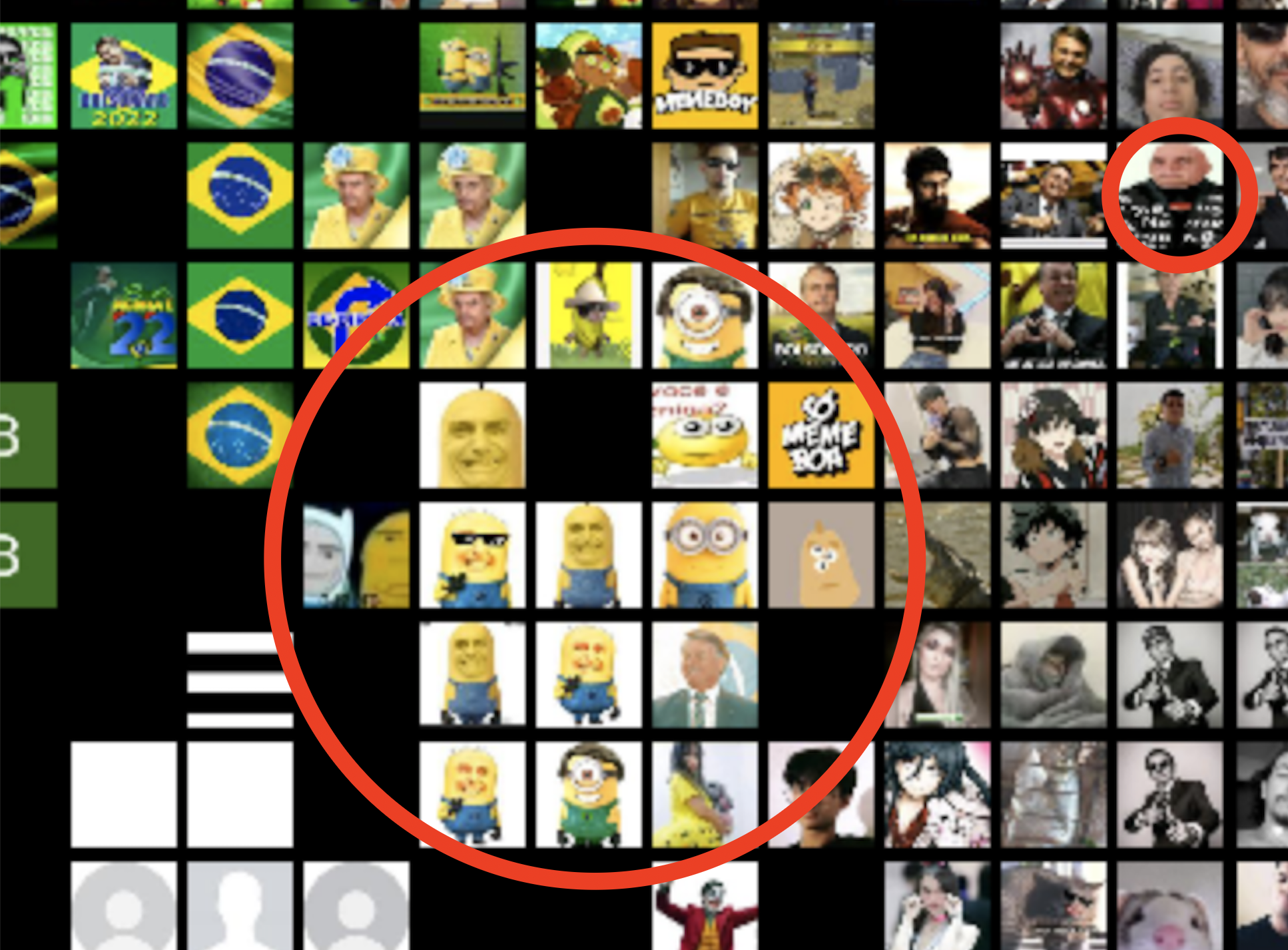
In the movies, the minions are an army of loyal, interchangeable and replaceable little underlings whose sole purpose is to serve the wishes of their „despicable” and evil master Gru. They also display little distinct identity or agency apart from their function in fulfilling his goals.
The term “bolsominion” originated during Bolsonaros presidential run in 2018, first used by his opponents as a pejorative to refer to his supporters, considering them, “like the minions, as subjects that do not question orders, logic or truthfulness: they only act according to the need of their boss’s social ascension” (Oliveira, 2020, p. 70, translation self). However, it was reappropriated by the supporters of Bolsonaro as a term of self-description and endearment.
Account names on TikTok that use “bolsominion” combine it often with others of our keywords like „direita“, „gay“, “mito” „opressor“ or „soldado“ or other recurrent qualifiers like “com amor”, “forever” or “policial”. Apart from images referencing the Minion-movies and other memes, we also noticed an overrepresentation of ghost accounts when analysing the profile pictures.
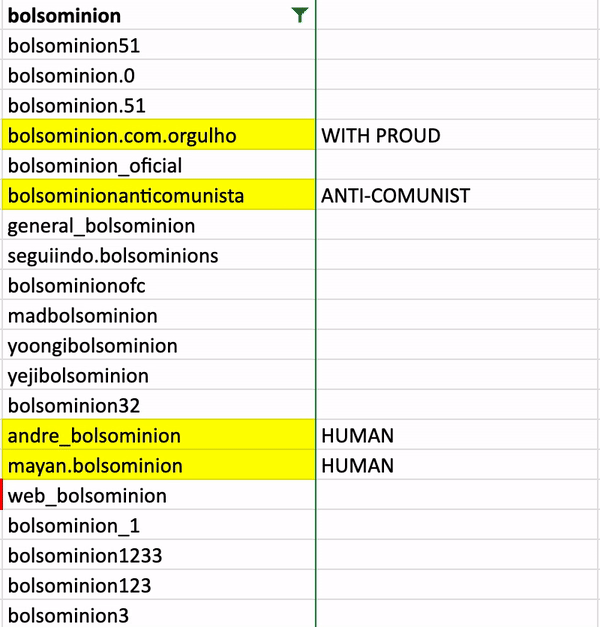
A probe into the non-ghost-accounts (i.e. those that actually had videos on them) led us to identify three different types of accounts:
- The most typical pattern: a mixture between memes regarding Bolsonaro (and sometimes political competitors), “culture war”-topics and/or presentation of the president as an authoritarian strong-man.
- A not insignificant number of accounts with videos unrelated to Bolsonaro, but with “bolsominion” in their (sub)title, sometimes even using anti-bolsonaro-hashtags such as #forabolsonaro. The assumption here is that these are random content channels, just trying to attract attention to themselves by using these charged keywords.
- A not insignificant number of accounts with videos unrelated to Bolsonaro, but with “bolsominion” in their (sub)title, sometimes even using anti-bolsonaro-hashtags such as #forabolsonaro. The assumption here is that these are random content channels, just trying to attract attention to themselves by using these charged keywords.
- A handful of accounts with human actors presenting themselves in the videos, some of whom have some of the highest follower numbers within the “bolsominion”-sample.
An interesting naming pattern can be observed in this last group. The account names often consist of what seems like the person’s first name plus the addition “bolsominion”. Almost as if they adapt the term as their last name, exchanging their family association with this alternative signifier of group identity that indicates their loyalty to their political leader. This can be perceived as a further affirmation of the negative traits implied in the creation of the term “bolsominion” as pejorative. This is especially interesting, when one also takes into consideration that the observed behaviour of these human-led “bolsominion” accounts was strikingly similar to genuine bot-accounts.
-
Twitter: Capturing and profiling bolsobots behaviour
The use of the botometer as a calculus for bot-like behaviour will be the central aspect of all the following arguments. First, however, we must argue that this metric is created by a series of patterns of users/bot’s behaviour. The idea here is not to support or oppose how these results were encountered. However, the main goal is to see what users or bots with bot-like behaviour impact the political debate, and even if this kind of behaviour/strategy has changed over time. To put it in a sentence, we will analyse bots beyond its detection, trying to understand their cultural and political impacts.
Once a bolsobot, always a bolsobot?
The first aspect must present the enormous increase of bot-like activity during crucial moments of political disputes. This ‘computational propaganda uses of politicized social bots in different roles’ (Duh, Slak Rupnik, & Korošak, 2016, p. 114) calls for the inclusion of not only social media, but also bots into the analysis of political discourse. The data-set of tweets from bolsobot accounts were extracted from Twitter using a series of previously stated queries. These users had their profiles scanned by botometer and received a score between zero and one with zero having no bot-like behaviour and one to be almost certainly a bot. The first graph is a histogram that divides users based on their scores; the colours are assigned by their “class”, which can be “low”, “medium” and “high” bot-like activity. “Classes” are distributed by dividing the probability into three groups: ranging from 0 to 33%; 34 to 66%; and finally, 67% to 100%. This graph presents how users are normally distributed around a value of 80% bot-like behaviour, which is considerably high. The peak of users with such a high score makes it an urgent topic for discussion. The main question is how do these bot-like users act, and what is, and was, their role in the campaign for Jair Bolsonaro’s presidency between the years 2017 to 2021? Moreover, knowing that most users in the data-set had a score between 67-100%, doesn’t mean that this distribution was always like this.

The second graph shows the distribution of tweets between these three classes from 2018 to December 2021. As we can see, the number of tweets increases enormously in key moments of Brazilian politics. This fluctuation is not surprising as it is common for Twitter to accompany relevant political debates (Boyadijan, 2014; Giglietto et al., 2015). However, the most pertinent change is at the end of 2021, when users with high bot-like scores overcome the number of tweets from others with lower scores. This most likely originated from the arrival of the 2022 elections, and preparing the ground for the new campaign.
As we can see, the peek in post numbers was from three different moments during our data-set: the 2018 elections, which had massive support on Twitter for Bolsonaro. Then, again, at the end of 2019, when it had come to light the corruption scandal called “rachadinha”, which consisted of Bolsonaro’s son, Flávio Bolsonaro, hiring “ghost workers” for congress that would not come to work but deposit a great amount of their salary in his account. Finally, the last peak was at the end of 2021, already preparing the ground for the 2022 elections that will happen during the second semester.
The number of hashtags is also a prominent aspect that has changed over time. As we can see in the third graph, the number of hashtags mentioned in 2021 has surpassed 400.000, a 167% increase from its former maximum value of 150.000 in 2020. This enormous increase may also suggest that users might have removed content from the platform, and by that logic, the number of posts from earlier years would be underestimated. The increase of content regarding Bolsonaro is not surprising, and he was always portrayed for his strong social media presence, since his first election in 2018 (CESARINO, 2020).
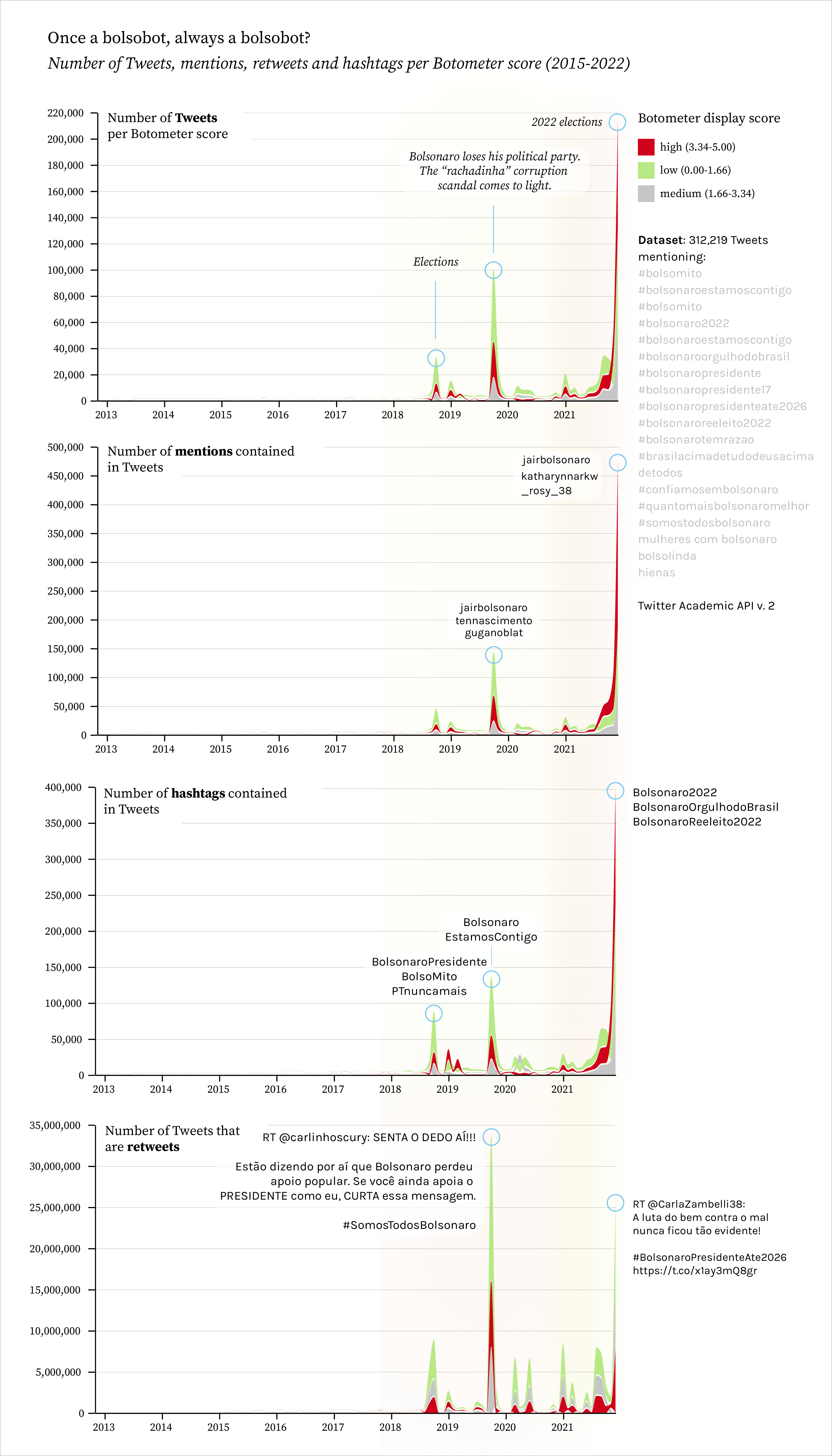
As seen in the first graphs, there is a progressive increase of non-bots in the public debates, especially in 2021. However, are these bots (or bot-like users) starting the discussion, or are they simply retweeting and “creating volume” for the platform? To see this, let’s take only the first appearance of specific hashtags. We then use the botometer score for these users to check if, in general, the creation of trends that offer support for Bolsonaro is organic or not.
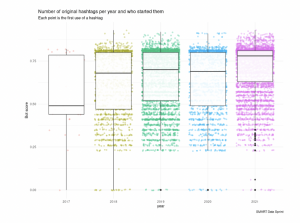
In this graph, each point represents the first appearance of a hashtag. Point positions are structured by year (on the x axis) and the botometer score of their author. The boxplot shows the distribution of points based on quartiles; the black line that cuts the boxes in the middle represents the median. This graph shows that the median position from who created the first hashtag has progressively moved from users that had more organic behaviour to more bot-like behaviour: while in 2017, the usual creator had a score of only 50%, the following three years got around 65-70% and finally more than 75% in 2021.
This understanding doesn’t mean that bots don’t retweet or simply that they are the sole point to start some campaign. The following graph shows the distribution of types of tweets by botometer score. As we can see, the only group that retweets more than posts original tweets are those considered to have 80-89% bot-like behaviour. As earlier presented, this is, by far, the densest group in our distribution. However, one counterintuitive fact is that accounts that have a 100% bot-like distribution only retweet in roughly 20% of their posts, having most of them being original tweets.
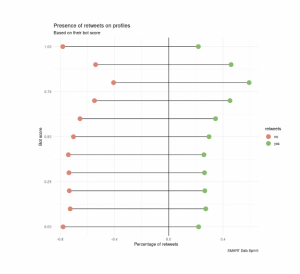
What bolsobots talk about when they talk about Bolsonaro
When considering how bolsobots talk, it is necessary to understand the possible platform affordances. Twitter allows users to interact with one another and even create patterned content using replies, hashtags and links. Using the groups of high, medium and low Botometer scores we divided between the average number of hashtags, links and mentions per post. As always, this is divided by the botometer score.
It is possible to see how users with a high botometer score tend to mention a lot more users than those with lower scores, with an average of 5.5 mentions per tweet. This can be attributed to two main aspects: first, users with bot scores that are higher tend to reply more, which would make it mandatory to quote the person (or persons) that the user is replying. These replies are one classical way of using bots that automatically reply in given circumstances. Also, name-dropping, is a strategy of simply mentioning multiple users at once to get more attention to specific matters. Made, normally for two aspects. As we see, the distribution of the other two, links and hashtags, is less concentrated on the top. Users with low scores, such as 10% have around 3.6 hashtags per post and 0.8 links per post. These are divided more constantly throughout the distribution.
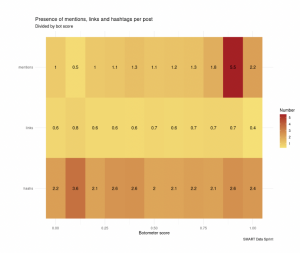
As for the specific hashtags used, we can see that among all values, the most used was #bolsonaroestamoscontigo. These percentages are calculated for each botometer value (with one decimal case), this means, for instance, that from all hashtags that users with 50% botometer score used, 17.7% were #bolsonaroestamoscontigo (reads Bolsonaro, we are with you). Here we can see two main things. First of all, there is some homogeneity between the hashtags and users from all botometer scores. However, those with a more bot-like attitude distribute their hashtags in the broader group, mostly concentrated in the top three groups: #bolsonaroestamoscontigo, #bolsonaro2022 and #bolsonaroorgulhodobrasil.
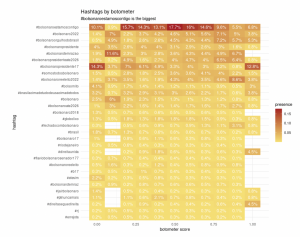
Top 10 hashtags
#bolsonaroestamoscontigo - 237513
#bolsonaro2022 - 127129
#bolsonaroorgulhodobrasil - 116031
#bolsonaropresidente - 105087
#bolsonaropresidenteate2026 - 103190
#bolsonarotemrazao - 99473
#bolsonaroreeleito2022 - 94726
#bolsonaropresidente17 - 92840
#somostodosbolsonaro - 92308
#bolsomito - 56174
Looking again at the creation of hashtags, we can see a pattern in almost all years in the distribution. The ratio of new hashtags per user was more centred on high-score users. In other words, this indicates a great variety of hashtags in users that are most likely to be bots rather than organic users of the platform. Again, as was shown in an earlier graph, 2021 seems to be the year with the greatest amount of original hashtags coming from non-authentic users.

If we see the number of original hashtags per year, it becomes clear that 2019 and 2021 were central years in creating the vernacular these users would communicate. Of course, the average time for a hashtag to achieve its peak can vary a lot. However, for hashtags used at least 10 times in a day, the average days between being published the first time and catching on were 189 days, if we take hashtags that were tweeted more than 100 times, it goes to 247 days, and for more than 1000 it took on average 406 days.
|
Year |
Original hashtags |
|
2017 |
1.228 |
|
2018 |
8.655 |
|
2019 |
11.483 |
|
2020 |
5.112 |
|
2021 |
10.791 |
The construction of bot vernacular takes time, and even hashtags considered quite fluid matters can come back at some point. As we can see in the following graph, the use of hashtags that were created in other years is a crucial point for every year of campaigning. For instance, the most creative year of all, 2019, when Bolsonaro was being accused of corruption by the “Rachadinha” scandale, had a group of hashtags used in total more than 300.000 times in 2021.
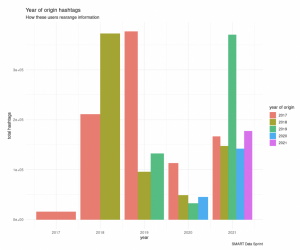
The time to create a vernacular between users can vary a lot and deserves deeper investigation. The construction of linguistic vocabularies are tools for disputing the public opinion as well. However, in which concerns bot activity, we can see what the average duration of hashtags based on different botometer scores is. Removing all hashtags that lasted less than a day, the distribution tended to last more when they were originally created from accounts that didn’t behave as much like bots.
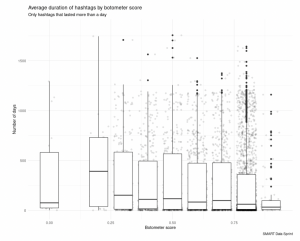
The role of bots as producers or reproducers of content is a central aspect to understand political disputes on platforms. In the following section, we will discuss how bots discuss being bots, how the topic has been progressively reshaped by the strong affiliation from Bolsonaro supporters considering themselves to be bots. In contrast, actual bots would try to mimic progressively more non-bot behaviour.
You are not the bot I used to know
Bots that display what users consider human-like behaviour are more likely to interact with other accounts, that is, receive replies from human users and initiate interaction with human accounts (Wischnewski, Ngo., Bernemann, Jansen, & Krämer, 2022). Bots have been part of the social media landscape since the inception of these platforms. Platforms, users and bot developers have continuously changed to keep up with evolving demographics, as having discourses about what constitutes inauthenticity or “fakeness” in relation to bots (Beskow, & Carley, 2019).

Keeping this in mind, we have explored what pro-Bolsonaro users (i.e., users tweeting hashtags in favour of Bolsonaro) consider to be “bots” over time. We find that in the aftermath of the explosive revelations about the existence of Carlos Bolsonaro’s specialised cluster for inauthentic coordinated activities – the so-called “Gabinete do Ódio” (Cabinet of Hate) – made by congresswoman Joyce Hasselman, many pro-Bolsonaro users actively appropriate accusations that they may be “bots”. These users are for the most part authentic, by the measure of their Botometer score. However, users who claim they are not bots are detected as bots.

When calculating the overall Botometer scores of users claiming they are and are not bots, we see that the majority of authentic users claim they are bots or “bolsominions” – i.e., Boslonaro sycophants – while the majority of inauthentic users claim they are not bots and are not bolsominions.

When breaking down their Botometer scores, we see that nearly all users have high “echo chamber” scores; i.e. whether they are inauthentic or not, they engage in follow-back groups, share and delete political content in high volume. Inauthentic users are distinct here in that they are likely to be fake followers, spammers or even self-declared bots.
Discussion: Have we entered the post-bot era?
As we mentioned above, when the “bolsominion“ label was created many Bolsonaro supporters adopted it as terminology for self-description and endearment despite the negative assumptions associated with the label, seemingly even playfully affirming their implications. Similarly, when the extent of the deployment of bots in Bolsonaro’s 2018 electoral campaign became public, some of his supporters claimed the bot-label for themselves, in an effort to lead the idea ad absurdum that automated accounts could have astro-turfed the support for their political movement. The hashtag #eusourobôdobolsonaro (I am a bot of Bolsonaro“) became a trending topic and a video made the rounds that showed a group of Bolsonaro-supporters walking in a robot-like manner and repeating the slogan in monotone, robot-like tone.
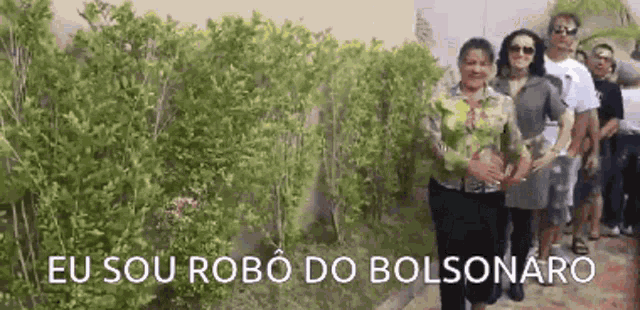
Watch the video with sound here: https://www.youtube.com/watch?v=XyzPzZDcdW4
Obviously these reappropriations of labels are meant humorously, but taken literally the self-identification as a “bolsominion” or a bot seems akin to a rejection of notions of personhood itself. Notions such as autonomy, critical thinking and individual responsibility. Notions that are not very highly regarded in far-right movements like Bolsonaro’s anyway.
To now find that the online behavior of parts of his electorate resembles that of actually automated accounts, puts this (half-)joking rejection of agency into a new light.
At the same time, we see inauthentic accounts claiming personhood for themselves, further blurring the lines. This led us to question whether we might enter a post-bot era, where the meaningful distinction between human and automated actors becomes increasingly harder and maybe even less important.
This project captured and profiled bolsobots accounts in two distinctive ways. First, and based on previous empirical evidence, we manually listed Tiktok accounts with keywords and username repetitive patterns as signals for fully or partially automated profiles. By close reading the description and profile pictures with various digital methods, we detected the particular strategy of bolsobots on TikTok: a combination of textual and visual elements. These accounts state different matters of concern associated with Jair Bolsonaro’s political and ideological agenda through text (profile description). For example, bot profiles mention the 2022 Brazilian general election using emojis like 🇧🇷 or 💚 💛 to indicate a broader loyalty to “bolsonarismo” ideas. They also engage with a specific vocabulary of different social debates, e.g. Deus, amém, cristão, fé (religion). In addition to that, account names serve as “political slogans” (fechadocombolsonaro45, bolsonaro22opressor, presidente_bolsonaro, bolsonaropresidente.2022) while integrating social and cultural agendas such as family and religion, conservatism, LGBT community and memes. The visual strategy spreads Bolsonaro’s emphatic, likeable and memetic persona, yet putting away his extreme political positing stance. Bolsominions accounts have a crucial role here. However, account names do not necessarily match the profile picture. Although simple, this is quite a strategy of being present. So, yes, bolsobots are creative; they know what they are doing. The results do not cover how bolsobots operate on TikTok nor describe their following network. Instead, it provides a glimpse of bots presence and what they look like, reflecting on possible social effects.
Second, relying on the botometer, we quantitively approach Twitter bolsobots. This tool detected a value of 80% bot-like behaviour on our dataset, which is considerably high. We found that the lines between “bots” and “not bots” blur as automation, authenticity and partisanship become interchangeable in online political militantism. Two main aspects led us to this conclusion. The first reflects political bots expected behaviour, so to speak: bolsobots provide massive support on Twitter for Bolsonaro in moments of political scandals (Rachadinha) and elections (2018 and 2022). Yes, bots will always be bots; they never disappoint. The other aspect supporting our final argument, our most significant finding, captures intriguing bot and human behaviours; authentic users mimic bots while inauthentic users claim they are not bots.
Bolsobots are pushing us beyond what we used to know about bots and how we used to study them. If we want to keep up with their strategies and operational modes, we should make room for new methods and techniques to check these accounts.
Al-Rawi, A., Groshek, J., & Zhang, L. (2018). What the fake? Assessing the extent of networked political spamming and bots in the propagation of# fakenews on Twitter. Online Information Review.
Beskow, D. M., & Carley, K. M. (2019). Its all in a name: detecting and labeling bots by their name. Computational and Mathematical Organization Theory, 25(1), 24-35.
Boyadjian, J. (2014). Twitter, un nouveau «baromètre de l’opinion publique»?. Participations, (1), 55-74.
Bradshaw, Samantha, Hannah Bailey, and Philip N. Howard. 2021. “Industrialized Disinformation: 2020 Global Inventory of Organized Social Media Manipulation.” in Working Paper 2021.1. Oxford. UK: Project on Computational Propaganda.
Cesarino, L. (2020). Como vencer uma eleição sem sair de casa: a ascensão do populismo digital no Brasil. Internet & sociedade, 1(1), 91-120.
Chao, J. (2021). Memespector GUI: Graphical User Interface Client for Computer Vision APIs (Version 0.2) [Software]. Available from https://github.com/jason-chao/memespector-gui.
Duh, A., Slak Rupnik, M., & Korošak, D. (2018). Collective behavior of social bots is encoded in their temporal twitter activity. Big data, 6(2), 113-123.
Eddelbuettel, D. (2021). digest: Create Compact Hash Digests of R Objects. R package version 0.6.29. https://github.com/eddelbuettel/digest
Euronews (2021, September). Fake news fear as Bolsonaro bids to limit social media content removal. Available at: https://www.euronews.com/2021/09/07/fake-news-fear-as-bolsonaro-bids-to-limit-social-media-content-removal
Giglietto, F., Rossi, L., & Bennato, D. (2012). The open laboratory: Limits and possibilities of using Facebook, Twitter, and YouTube as a research data source. Journal of technology in human services, 30(3-4), 145-159.
Grimme, C., Preuss, M., Adam, L., & Trautmann, H. (2017). Social bots: Human-like by means of human control?. Big data, 5(4), 279-293.
Jung, Klaus et al. “PicArrange – Visually Sort, Search, and Explore Private Images on a Mac Computer.” MMM (2022). https://arxiv.org/abs/2111.13363v1
Lobo, T. and Carvalho, D. (2018, September). Robôs e desinformação nas redes: o que já se sabe nas eleições 2018. Nexo Jornal. Available at: https://www.nexojornal.com.br/ensaio/2018/Rob%C3%B4s-e-desinforma%C3%A7%C3%A3o-nas-redes-o-que-j%C3%A1-se-sabe-nas-elei%C3%A7%C3%B5es-2018
Maier, Nils; Parodi, Federico & Verna, Stefano (2007). DownThemAll (Version 4.04) [browser extention] . Available from https://www.downthemall.org/
Maréchal, N. (2016). Automation, algorithms, and politics| when bots tweet: Toward a normative framework for bots on social networking sites (feature). International Journal of Communication, 10, 10.
Militão, E. and Rebello, A. (2019, September). Rede de fake news com robôs pró-Bolsonaro mantém 80% das contas ativas. UOL. Available at: https://noticias.uol.com.br/politica/ultimas-noticias/2019/09/19/fake-news-pro-bolsonaro-whatsapp-eleicoes-robos-disparo-em-massa.htm
Peeters, S. & Hagen, S. (2021). 4CAT Capture and Analysis Toolkit (v1.18). Zenodo. https://doi.org/10.5281/zenodo.4742622
Oliveira, N. R. D. (2020). A Febre Amarela “Minions”: Uma Análise Bakhtiniana. Universidade Estadual Paulista. Available at: http://hdl.handle.net/11449/192052
Omena, J., Lobo, T., Tucci, G., Kerche, F., Paschoal, M., Ji, X., Rodarte, A., Griffiths, E., Zaffaroni, L., Amadori, G. and Huang, S. Digital Methods Initiative (DMI), Summer School 2021. Profiling Bolsobots Networks. Available at: https://wiki.digitalmethods.net/Dmi/SummerSchool2021BolsobotsNetworks
Omena, JJ, Chao, J, Pilipets, E, et al. (2019) Bots and the black market of social media engagement. Digital Methods Initiative Summer School Wiki. University of Amsterdam, 22 August. Available at: https://wiki.digitalmethods.net/Dmi/SummerSchool2019Botsandtheblackmarket
Sandy, M. (2021, September). Bolsonaristas Utilizam Robôs Para Impulsionar 7 De Setembro No Twitter. Congresso em Foco. Available at: https://congressoemfoco.uol.com.br/projeto-bula/reportagem/bolsonaristas-utilizam-robos-para-impulsionar-7-de-setembro-no-twitter/
Santini, R. M., D. Salles, and G. Tucci. 2021. “When Machine Behavior Targets Future Voters: The Use of Social Bots to Test Narratives for Political Campaigns in Brazil.” International Journal of Communication 15:1220–43.
Steinert-Threkeld, Zachary C. 2018. Twitter as Data. 1st ed. Cambridge University Press.
Varol, Onur, Emilio Ferrara, Clayton A. Davis, Filippo Menczer, and Alessandro Flammini. 2017. “Online Human-Bot Interactions: Detection, Estimation, and Characterization.” P. 10 in Proceedings of the Eleventh International AAAI Conference on Web and Social Media.
Wischnewski, M., Ngo, T., Bernemann, R., Jansen, M., & Krämer, N. (2022). “I agree with you, bot!” How users (dis) engage with social bots on Twitter. New Media & Society, 14614448211072307.
Woolley, S. C., & Howard, P. N. (2016). Automation, algorithms, and politics| political communication, computational propaganda, and autonomous agents—Introduction. International Journal of Communication, 10, 9.

